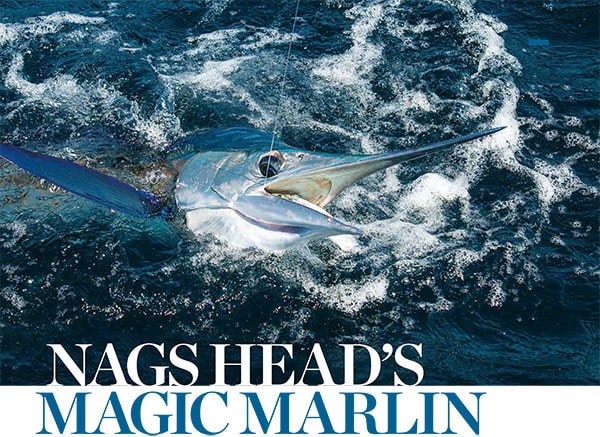
I’ve never been very good at geography. I’ve always assumed that Oregon Inlet was in Oregon, and I never could figure out how it could be a gateway for exceptional marlin fishing. I knew about Hatteras and North Carolina’s Outer Banks — I’d even heard of Nags Head — but unfortunately, I never had the opportunity to fish the area until Brant Wise invited me up there for a few days in August.
I first met Wise in Isla Mujeres, Mexico, where he keeps his 53-foot custom Carolina sport-fisherman, Swordfish, from January through March. Wise was the first captain to give me the opportunity to swim with sailfish balling bait, and during that trip, he raved about the marlin fishing in both Hatteras and Oregon Inlet. He promised to give me a call when the white marlin bite turned on and told me to be ready from mid August through September.
The call came during the third week of August. A few days later, I was on a plane heading to Norfolk, Virginia, home of the closest airport to the Outer Banks. Wise picked me up at the airport, and 90 minutes later, we were cruising by the Oregon Inlet Fishing Center. I couldn’t believe what I saw as we cruised past the boats — most of them flew 10 or more release flags. That’s a lot of whites! The bite had been outstanding for a week or so, and all I needed was for it to hang on for another two days. The whites congregate in an area about 40 miles northeast of Oregon Inlet where the Gulf Stream and the Labrador Current merge. Swordfish was docked at Broad Creek Marina, and the run averaged about two hours until lines in, so we planned to be at the dock at 5:30 a.m.
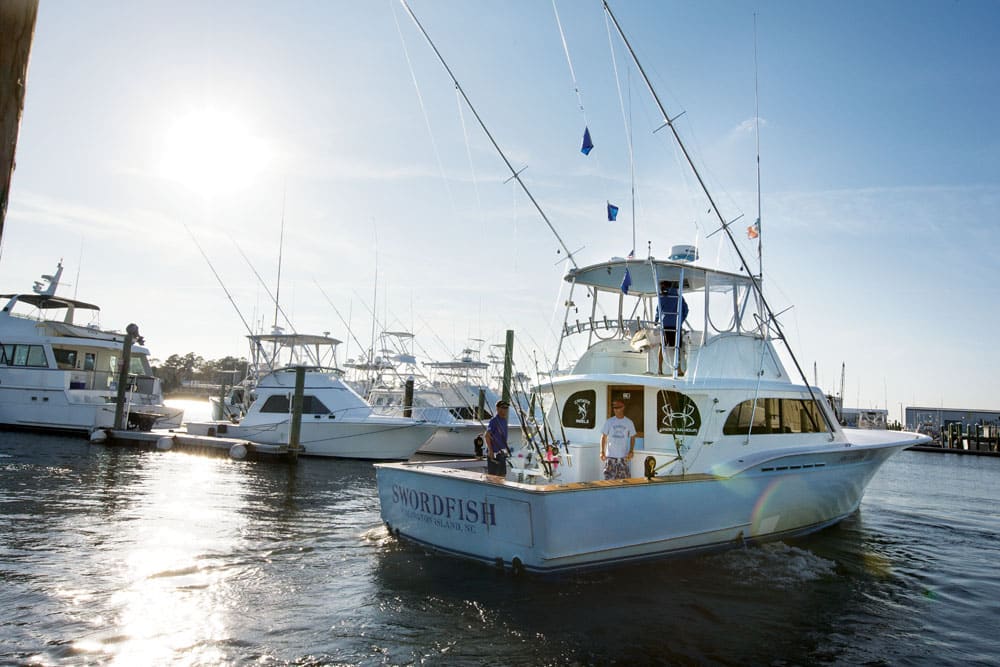
Historic Fishery
Although the Outer Banks enjoy a long and storied history, the whole area was new to me. The towns wore cool names, such as Nags Head, Roanoke Island, Kill Devil Hills, Kitty Hawk, Bodie (pronounced “Body”) Island and Stumpy Point, each with a lot of character and its own unique legend about how it got its label. And of course the boats here are pretty special as well. This area is known for its sporty seas when the winds kick up, so most of the boats boast true Carolina-style hulls, with sharp entries and a wide bow flare that makes them particularly suited for rough water. Swordfish was originally built by Paul Mann of Paul Mann Custom Boats, and it can handle heavy seas as well as any boat on the water, which I appreciated because it was blowing 20 knots when we left the dock that first morning.
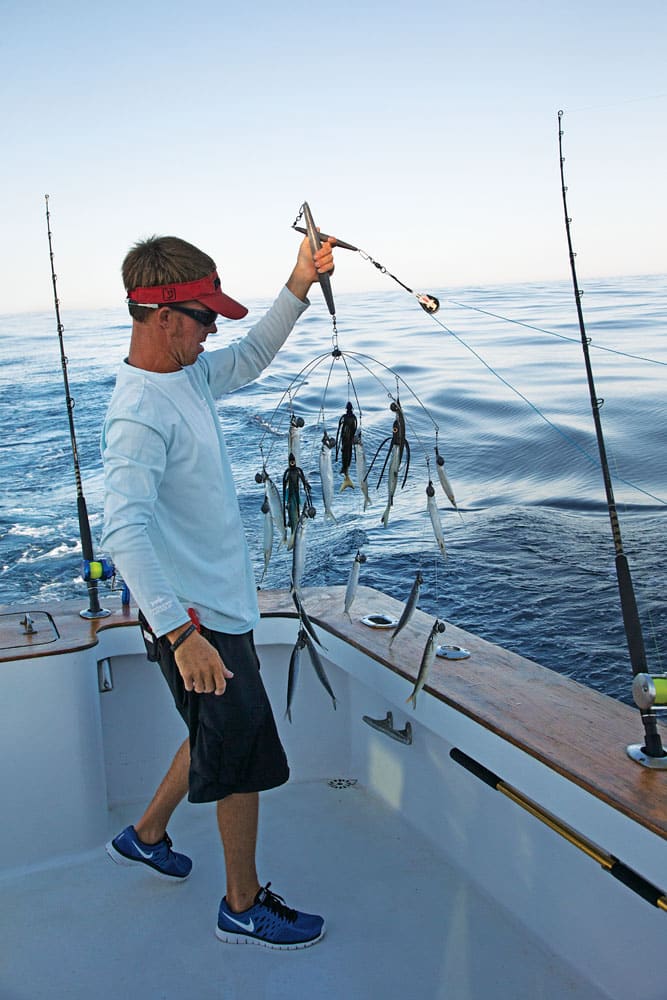
Getting to It
I had fished with Capt. Jim Ashley and mate Lee Scarborough in Isla Mujeres, so we were already good friends. Wise invited his wife, Maria, along with Haley Huggins and Tara Stromberg to help out with fishing. All I wanted to do was take pictures, but that doesn’t work out too well if there’s no one in the cockpit to catch the fish.
When we reached the fishing grounds, Ashley settled in on the bridge while Scarborough set out the lines and teasers. They ran two dredge teasers rigged with ballyhoo and mullet. They also mounted a GoPro camera in the center, which allowed us to see what a 200-pound mako looks like when it comes in for a free meal. They pulled two daisy chains of squid teasers with a Sea Witch ballyhoo combo at the end. They pull an 80-pound rig with a lure for blue marlin and six ballyhoo on 20-pound Canyon reels for the whites. With only one mate, it takes considerable expertise to clear all the lines and teasers once a fish is hooked, but Ashley and Scarborough have it all down to a science. It’s pretty impressive to watch.
As we started fishing, Wise explained that when the wind blows from the northeast, like it had been for several days, the bait and the marlin start to bunch up. When the wind shifts to the southwest, like it had for us, everything starts to spread out. We hoped to see a few whites with maybe a stray blue marlin thrown in if we were really lucky. Tuna run in the fall and spring with the blue marlin showing up in late May. The whites take over in mid August and stay through September, unless a storm drives them out early. For some unknown quirk of nature, when the whites decide to leave, they all leave.
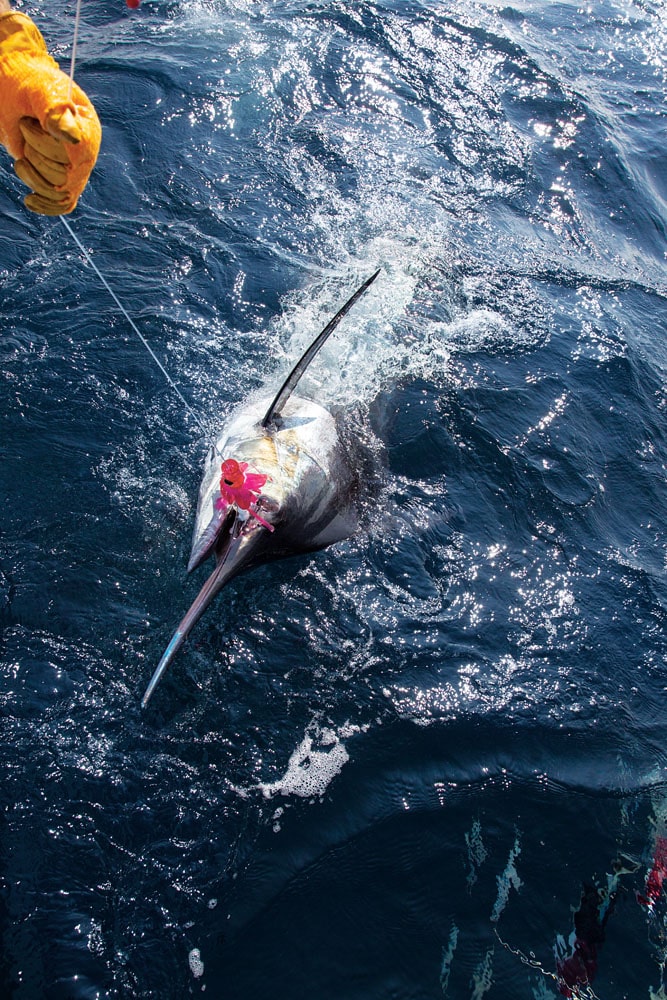
Although some boats experience those magical 20-fish days off Oregon Inlet from time to time, I was going to be happy just to get a few shots. I seem to have used up all my good karma on white marlin after catching an International Game Fish Association fly record in Venezuela in 1984. I’d seen only three or four whites since then, so when the first whitey swooped into the spread and pounced on a ballyhoo, I got pretty excited. Unfortunately, that excitement lasted less than three minutes when the hook pulled.
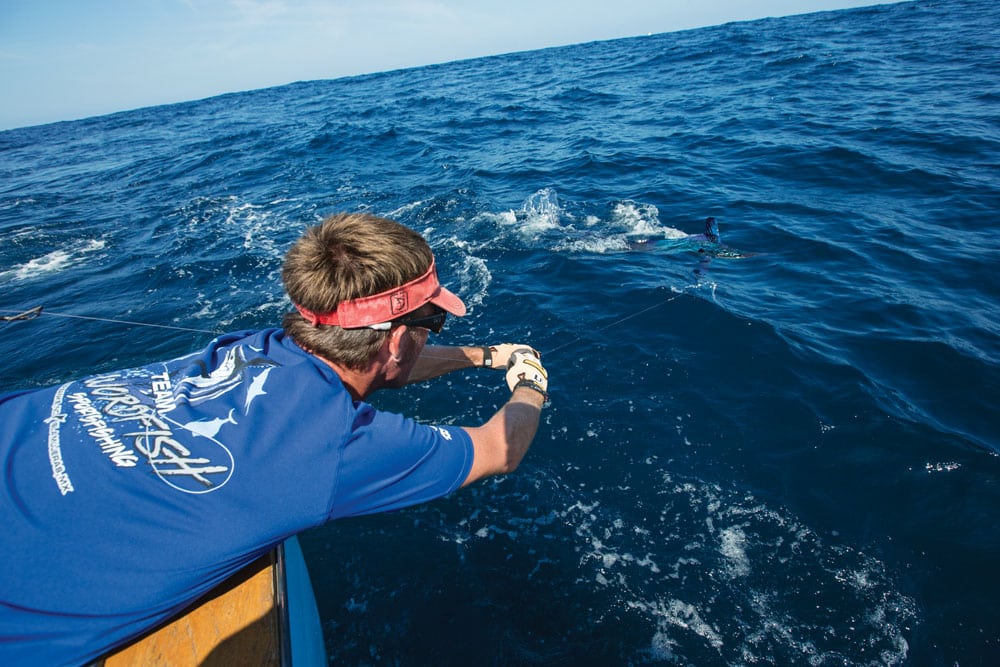
Half an hour later, a blue marlin appeared in the spread and politely affixed itself to the lure on the 80, just like it was supposed to. Huggins got her first-ever blue marlin to the boat in about 20 minutes, and things were looking up. The only downside was that the blue did all of its jumping about 200 yards from the boat. It wasn’t long after releasing the blue that Wise caught a nice white and then several more. We finished the day with a 200-plus blue and three whites out of five bites. The wind died down for the ride in, and seas were predicted to be appreciably calmer for the next day, so we were all pretty happy with day one.
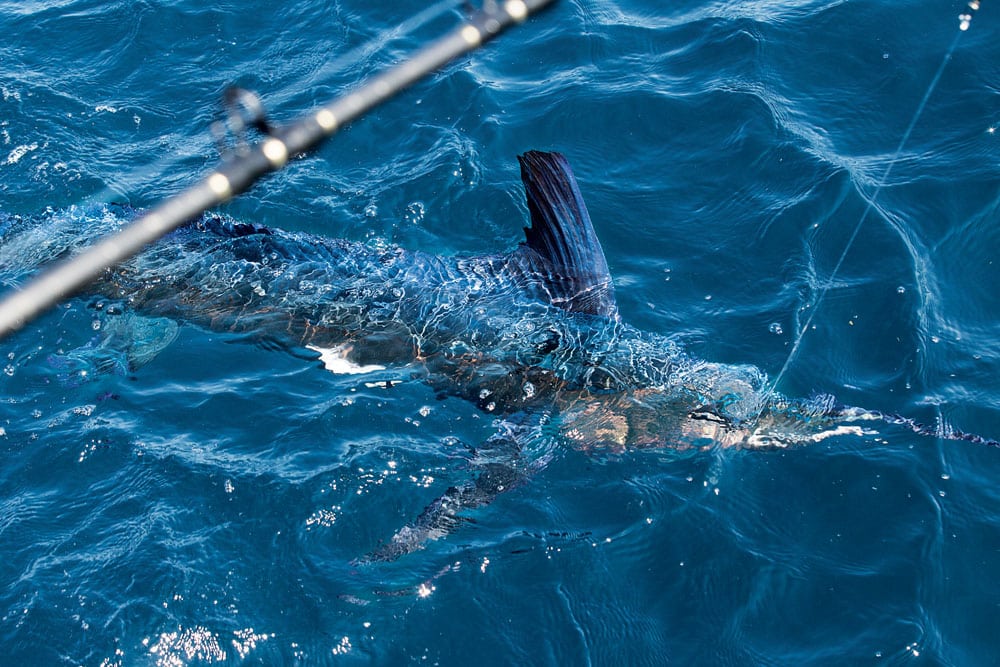
A Unique Encounter
I had only two days to spend with Wise, and there is nothing quite as optimistic as a fisherman starting out in calm seas at dawn. The run to the fishing grounds turned out to be a piece of cake that morning — most of us slept — and by 8 a.m., the lines were in and we were back in business.
The day before had been slower than we had hoped, but almost all the boats saw their numbers drop down appreciably from earlier in the week. Not everyone blamed it on the fact that I was there with a camera, but most probably thought about it at some point.
In spite of the cameraman, we did pretty well. Right off, Huggins caught a nice white that promptly threw its stomach, ruining any potential photos. Billfish often throw out their stomachs to get rid of something they ate that didn’t sit well. We caught a 700-pound black marlin in Panama a few years back that also threw its stomach; however, we had a diver/cameraman in the water when the mate grabbed the leader, and he was in perfect position when the hook pulled out. The diver said the marlin just lay there for a second until it figured out it was free, then it gave its head a slight shake, sucked its stomach back in and swam off only slightly worse for wear. It’s comforting to know that a thrown stomach does not hurt the fish, but it sure doesn’t help the photography.
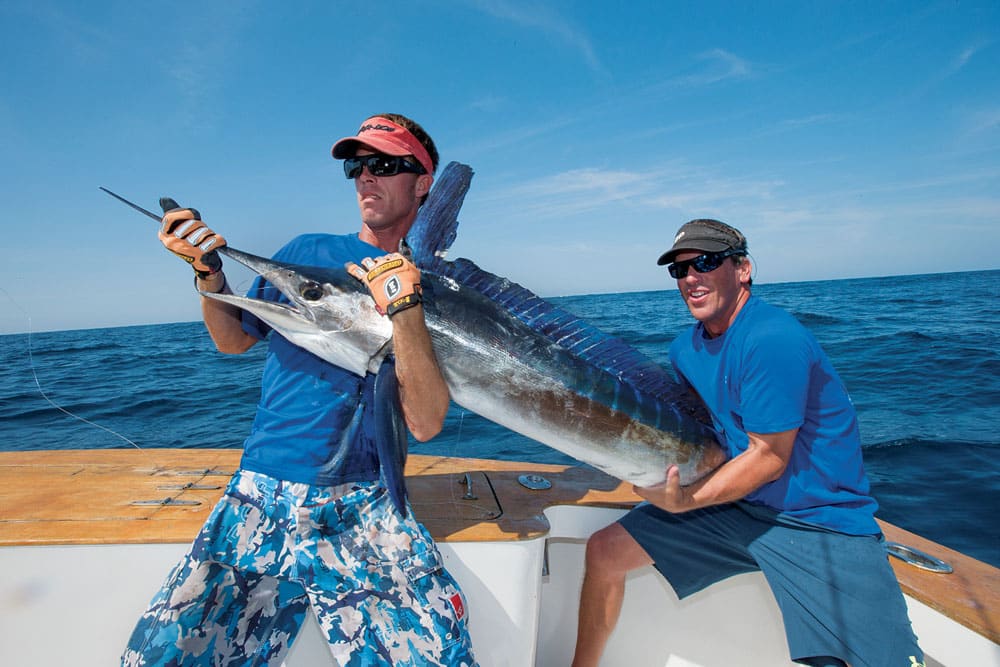
We did well on the whites that day going five for seven, with Maria Wise landing the largest one, which probably weighed around 80 pounds. Everyone caught one or more, and then Stromberg hooked a fish that didn’t quite fit the mold. It looked like a white when it struck, but it never jumped. Whites are usually crazy jumpers, so this fish was acting really weird. Stromberg worked the fish to the boat, and when we could get a good look at it, we saw its color was amazing. It was completely lit up and stayed that way. Its dorsal fin didn’t have any spots and was flat on top, not rounded like a white or spiked like a blue. It still wouldn’t jump, even when Wise tried to pull its head up for a photo. The markings were electric, and the colors never faded.
I snapped a bunch of photos wishing that I had time to put on a polarizing filter, but I knew that as soon as I left the cockpit, something exciting would happen and I’d miss it. Scarborough was the first to identify the fish as a “hatchet” marlin, aka a roundscale spearfish. I’d never heard of a hatchet marlin and never even seen a spearfish, but I had to agree that this critter didn’t look like any white marlin I’d ever seen and certainly didn’t act like one. Well, curiosity was killing us, and Wise had heard that the way to tell the difference between a white and a hatchet was checking the distance between the anus and the anal fin. That distance on a hatchet marlin is about 5 to 6 inches, while on a white, it’s 2 inches. To settle the discussion, Scarborough grabbed the bill, and he and Wise lifted Stromberg’s prize into the boat for a quick, but very personal, examination. Conclusion? We had just caught a roundscale spearfish. Our total for two days on the water was eight whites, a blue and a hatchet/spearfish critter — sailfish are never around when you really need one.
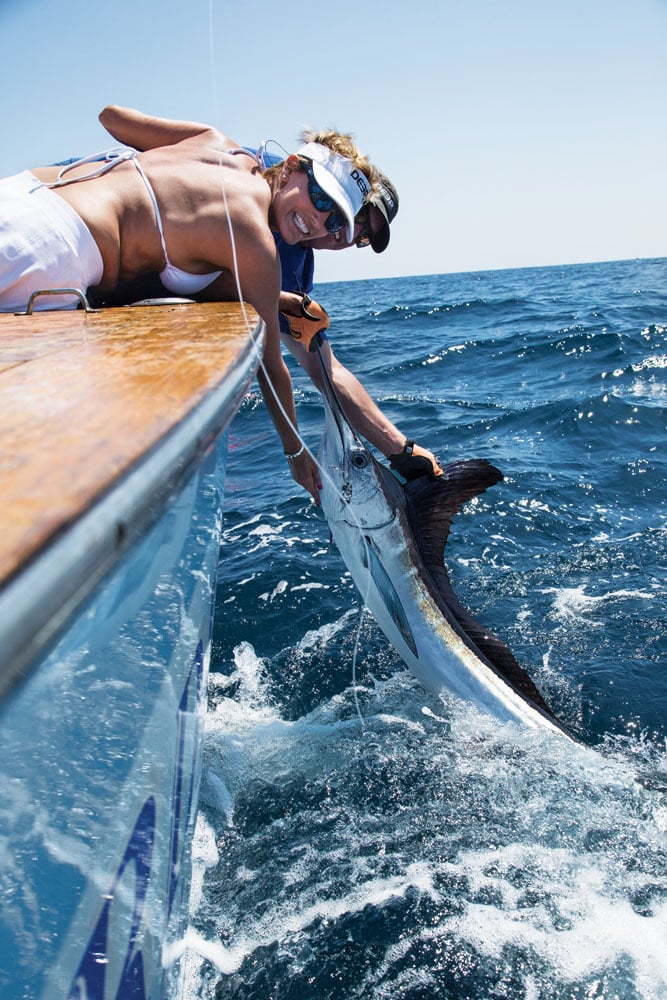
When I had time to look through my photos, I found a few that gave us a pretty good view of the spearfish. I sent them off to my friends at the IGFA, who confirmed the ID, and then, coincidently, Guy Harvey answered my email asking, “Where did you find the roundscale spearfish?” It’s good to have smart friends, but I still did a little research when I got back.
The “hatchet” tag on the roundscale spearfish comes from the fact that its dorsal fin is flat and looks like it has been lopped off with a hatchet. A genetic analysis by John Graves, chancellor professor of marine science at the The College of William and Mary Virginia Institute of Marine Science, confirmed that the “hatchet” was definitely not a white, and suddenly, there was an entirely new species to deal with.
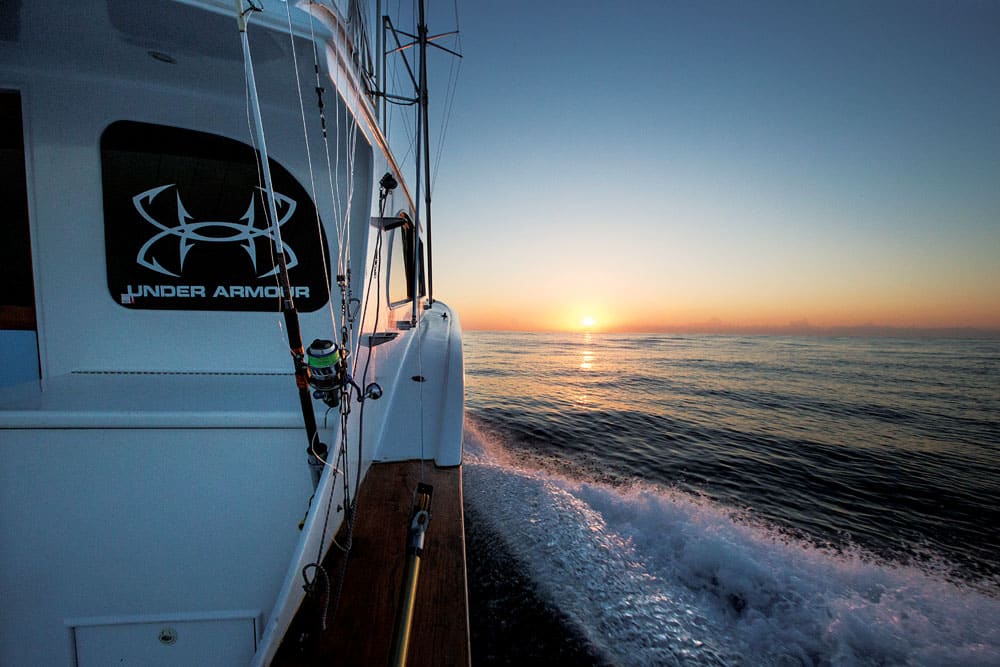
Graves has taken a DNA sample from every white marlin weighed in at the Mid-Atlantic $500,000 tournament every year since 1992. After reviewing all his results, he announced that 18 percent of the white marlin brought to the dock turned out to be roundscale spearfish, which indicates that these critters are a lot more common that one would expect.
This was a treat I never expected and will probably never repeat. But I will be back next year just in case luck decides to throw me another bone.







